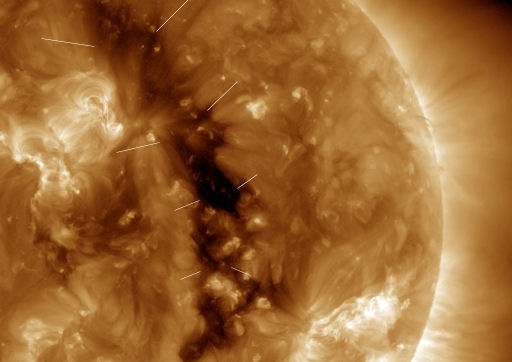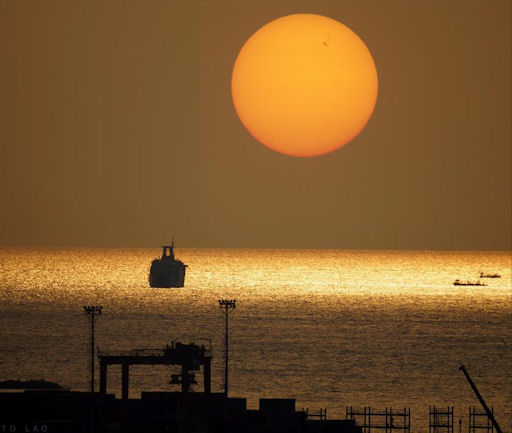Can you drop a probe on a comet? A new iPhone game from NASA's Jet Propulsion Laboratory puts you in control of the Rosetta spacecraft as it prepares to intercept Comet 67P/Churyumov-Gerasimenko. Download it now. | | | TWO INCOMING CMEs: A pair of solar eruptions on May 7th hurled coronal masss ejections (CMEs) toward Earth. Forecast tracks prepared by analysts at the Goddard Space Weather Lab suggests that clouds with arrive in succession on May 9th at 13:40 UT and May 10th at 07:54 UT (+/- 7 hours). The double impact could spark moderate geomagnetic storms. High-latitude sky watchers should be alert for auroras. Magnetic storm alerts: text, phone. CORONAL HOLE: A dark hole in the sun's atmosphere (a 'coronal hole') is spewing a stream of solar wind toward Earth. The impact of the stream, expected on May 9-11, could add to the effect of the incoming CMEs, boosting the chances of strong geomagnetic activity later this week. NASA's Solar Dynamics Observatory took this picture of the opening on May 8th: 
Coronal holes are places where the sun's global magnetic field opens up and allows some of the sun's atmosphere to escape. The outflow of gas is the solar wind. NOAA forecasters estimate a 40% chance of geomagnetic activity on May 9-10 when the stream arrives (along with the CMEs of May 7th). SUNSPOT SUNSET: Sunspot AR1476 is so large, people are noticed it without the aide of a solar telescope. The behemoth appears at sunrise and sunset when the light of the low-hanging sun is occasionally dimmed to human visibility. Alberto Lao sends this picture from Manila, the Phillippines: 
"The sky was hazy and a bit cloudy today, [perfect for sunspot photography]," says Lao. "Hoping to get a glimpse of AR 1476, I waited until a few minutes before sunset to try to image the sun . My patience was rewarded." With at least four dark cores larger than Earth, the sprawling active region is one of the largest sunspots in years. Moreover, it has a 'beta-gamma-delta' magnetic field that harbors energy for X-class solar flares. Any eruptions in the days ahead could be Earth-directed as the sunspot turns to face our planet. Solar flare alerts: text, phone. Caution: Even when the sun is dimmed by clouds and haze, looking into the glare can damage your eyes. Looking through unfiltered optics is even worse. If you chose to photograph the low sun, use the camera's LCD screen for viewfinding. Potentially Hazardous Asteroids ( PHAs) are space rocks larger than approximately 100m that can come closer to Earth than 0.05 AU. None of the known PHAs is on a collision course with our planet, although astronomers are finding new ones all the time. On May 8, 2012 there were 1287 potentially hazardous asteroids. Notes: LD means "Lunar Distance." 1 LD = 384,401 km, the distance between Earth and the Moon. 1 LD also equals 0.00256 AU. MAG is the visual magnitude of the asteroid on the date of closest approach. | | The official U.S. government space weather bureau | | | The first place to look for information about sundogs, pillars, rainbows and related phenomena. | | | Researchers call it a "Hubble for the sun." SDO is the most advanced solar observatory ever. | | | 3D views of the sun from NASA's Solar and Terrestrial Relations Observatory | | | Realtime and archival images of the Sun from SOHO. | | | from the NOAA Space Environment Center | | | the underlying science of space weather | | 
